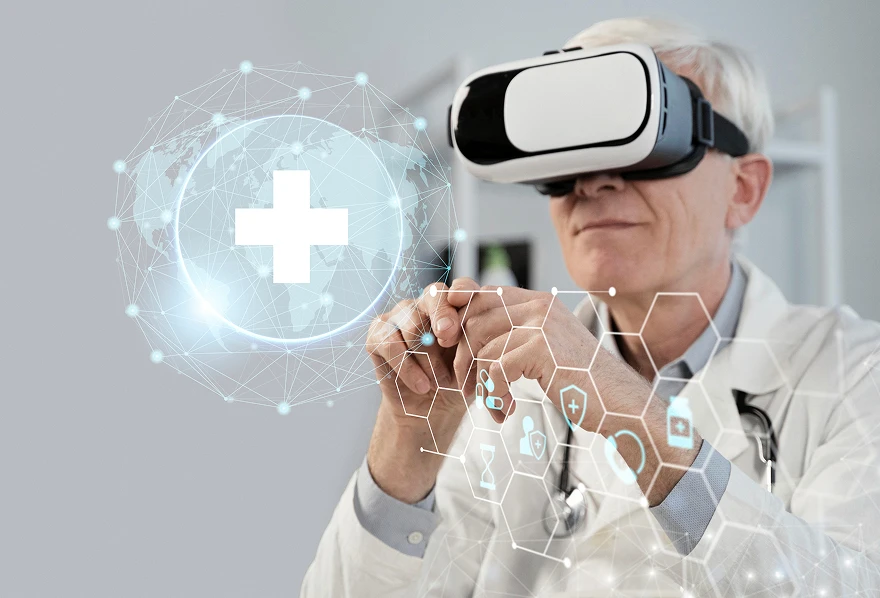As life speed accelerates, people start looking for more convenient and effective solutions at every step of their life. And the healthcare space should respond to the latest user needs and trends that emerge on a daily basis. Statistics show that patients are looking for quickly available yet effective healthcare services that they can book and pay for within seconds using any available gadgets.
Several clinics and hospitals in the U.S. have already powered their software with healthcare payment systems to meet those needs. Immediate payment allows for financial turnover for healthcare organizations in contrast to traditional insurance-based payments, which take too much time and are usually inconvenient.
Based on the Congressional Budget Office, approximately 60% of Americans get health insurance coverage through their work or buy policies by themselves. The same study shows that about 90 million U.S. citizens are insured via Medicare and the military. And more than 30 million Americans (10% of the U.S. population) said they had no health insurance coverage during 2021 and 2022.
Not all companies in the United States keep their platforms updated and suitable for modern realities. One of the reasons for that is that the healthcare industry is highly regulated, so it remains pretty resistant to innovations, including payment integration. Yet the increased demand for a smooth and efficient healthcare payment system allows for changes in that field, so now clinics and healthcare organizations can cover the latest users’ needs.
We created this how-to guide to help you learn more about healthcare payment integration, showing steps and tips for a better understanding.
Why Consider Payment System Integration in Healthcare in 2023?
Availability of Ready Healthcare Payment Systems
Although more time is required for the industry to fully adopt new billing systems, clinics won’t need to build a payment gateway from scratch in most cases. There are several product offers and providers that allow clinics and healthcare organizations to integrate billing systems and payment gateways easily, quickly, and in a cost-effective way.
Growth of Additional Paid Services in the Domain
Payment integration in healthcare allows clinics and companies to accept payments for a vast range of additional services aside from key ones. For example, clinics can offer lectures on kids’ health and wellness or extra health consultation and therapy sessions.
Thanks to the growth of telemedicine products, some healthcare organizations also want to improve their healthcare services, offering virtual visits, online booking, and remote patient monitoring. With digitalization, these services are becoming more popular among patients, yet traditional payment systems prevent clinics from expanding their service lists. As a custom telemedicine application development company, Interexy provides services and solutions being developed by a team of top-notch specialists.
Need for E-Commerce Standards in Healthcare
As mentioned, patients are looking for a convenient and smooth interface, as they see in various e-commerce platforms. And it involves the entire process from booking an appointment to a payment gateway so they can pay using various options like credit cards or even cryptocurrency.
Benefits of Payment System Integration in Healthcare
Increase Administrative Workflow Efficiency
When it comes to the healthcare domain, efficiency is a must. Healthcare payment integration in the U.S. allows front office staff to quickly verify and collect payments that are instantly posted and updated on the provider’s side.
This helps your staff to maximize their efficiency since there will be no need for switching programs to process payments from patients. Streamlining this business part reduces operational costs, promotes transparency, and saves labor resources.
Boost Revenues Cutting Down Costs
Traditional billing collection is a time-consuming process. And it is usually very costly. By using different types of payment systems in healthcare, clinics and organizations can optimize their center’s revenue cycle management (RCM). This helps reduce costs and boost the overall revenue.
Improve Patient Experiences
The need for smooth, convenient, and high-quality patient experiences is growing rapidly. The market is growing as well, so more and more clinics are offering various solutions for patients. That is why every clinic and healthcare organization should ensure they offer the best patient experience.
Patients now quickly move to a new provider if they are not satisfied with the care offered by your clinic. Increased competition makes it harder for clinics to cover users’ needs, yet payment integration is a fresh way to boost user engagement and satisfaction.
Minimize Human Mistakes
Healthcare organizations benefit from the re-designing of their payment systems and, therefore, reducing mistakes and errors. Thanks to less reliance on people during the payment process, healthcare companies will have fewer chances of human mistakes that are so common in traditional payment systems.
Seamlessly Communicate with the Tech Stack
Seamless and smooth communication between all technology solutions is a key priority for most healthcare companies that work hard to follow best practices within the industry and strive to be compliant with all regulations. In fact, a recent article from Deloitte mentions that “consumer-centric care and interoperability are the keys to success” in the upcoming years of the healthcare industry.
It has become more than a goal for clinics and healthcare providers. The Centers for Medicare & Medicaid Services implemented a guideline where clinics are required to share sensitive data with patients online via application programming interface (API) technology.
Types of Healthcare Software That Can Be Integrated with a Payment System
The choice of the integration platform depends on business needs, specific business models, goals, and other requirements. Below you will explore types of healthcare applications that can be potentially integrated with a payment gateway. However, it is
EHR/EMR Systems
Integrating healthcare billing solutions in combination with medical records allows your patients to access their consolidated payments and the entire history within their profiles.
This way, your app will securely store patient data in one place, providing higher convenience regarding quick online payments. The admin panel will show what patients have to pay and record successful payments.
HMS with Patient Invoicing and Billing Features
Make administrative tasks easier and faster by integrating billing systems into healthcare information-management solutions such as custom HMS. Send invoices to patients using automated invoicing features and billing processes.
You can also use A.I. tools to accelerate health claim processing. These tools include automated fraud detection and claim fulfillment. This will also help you reduce the time needed for financial transaction verification.

Telemedicine Apps Packed with Instant Payment Options
You can attract more patients via online marketing so they can book an appointment online and pay through their phone within seconds. Develop medical service portals powered by a telehealth consulting selection, online appointment booking, as well as the opportunity to make online payments.
Steps to Integrate Payment Systems in Healthcare Apps
Step 1: Collect Business Requirements and Goals
Before integrating the U.S. healthcare payment system into your software, you will need to collect business requirements and identify goals you want to achieve from integration. Your research will help you find the perfect option for your business or learn whether you need to build one from scratch or not. Explore competitors’ solutions in this domain and what extra features they use to power up their products alongside payment gateway.
Step 2: Find a Ready Solution
If your research shows that your product is suitable for ready solutions instead of building one from scratch, you can start exploring the market. Luckily, you can find a range of pre-made solutions for different types of applications, so you can find the one that suits you best.
Contact providers to get more information or hire a team to cover the entire process. Make sure that payment solutions will be compliant with the regulations the industry has for healthcare software.
Step 3: Embed Payment Functionality into Existing Systems
Integrating payments into a healthcare application will connect systems allowing for automatic data sharing. You can embed payment functionality within the existing provider-facing and patient-facing software to get an effective and seamless flow of data shared within these systems.
In the case of provider-facing systems, integrating payment solutions allows data to populate automatically into the existing system, reducing human mistakes and operational costs and boosting overall staff efficiency. This will minimize manual steps, allowing no space for errors and easier access to payment data. In addition, this helps to simplify the effect on existing systems or workflows.
Step 4: Integrate Omnichannel Payments into Your Processes
Healthcare payment system integration will enter every interaction and system in the existing workflow, opening new channels to gather payments. This will develop an omnichannel payment journey to give patients more access to information.
You can also boost the impact of omnichannel payments by integrating them into your existing processes. Educate your employees about new payment options so they can effectively communicate these options to clients.
Step 5: Test Integrated Solution
Testing is an essential part of the process so you can ensure the solution works the way it should. Your development and Q.A. team will work together, creating effective and stable payment processes and testing the security of payments.
Examples of Healthcare Payment Systems
As we mentioned, the demand for smooth and efficient payments enabled the industry to use ready solutions. There are currently several platforms that provide “Payment as a Service” and “Banking as a Service” solutions while also offering outsourced cloud-based payment management products. Below you will see the three most bright examples of the existing healthcare pymt system:
Zift
It is a California-based Payment as a Service provider. It offers API-based technologies that combine a range of tools for the modem healthcare payment ecosystem. For example, it uses different payment options such as EMV, ACH, and more.
UniPay Gateway
It is a well-known payment-management solution and is mostly used by U.S. clinics today. It offers omnichannel payment processing, payment terminal support, merchant underwriting, as well as extra payment options, such as crypto payments.
Stripe
Stripe is a leading payment system for the healthcare industry, yet it is used in other industries as well. It is an e-commerce provider offering a vast range of flexible technological advantages and options, including pre-built integrations for card networks and banking and optimized web-based checkout flows.
You can choose one of these payment options for your healthcare practice. However, it is always best to have a trusted team by your side to find the solution that suits your business needs best.
How Can Interexy Help?
Interexy is a leading healthcare development company offering staff augmentation and outsourcing services. We provide healthcare application development services for private clinics and healthcare organizations looking for stable, secure, and efficient solutions being developed by a team of top-notch specialists. Our developers have relevant expertise and a strong background in the industry, ensuring final products are compliant with strict industry guidelines. We assist in every step of the process and help your practice attract new clients in a modern yet safe way.
Final Thoughts
With the increasing need for more convenient and efficient care, clinics and healthcare organizations globally are considering health payment system integration. Traditional payment systems are outdated, rigid, and time-consuming while also tending to have many human mistakes. Payment integration helps improve patient access to their healthcare data, reduce mistakes, increase client satisfaction, and reduce manual work. Book a free call with one of our experts to discuss your needs and get more details on your case.
FAQs
What is the new payment system in healthcare?
In contrast to traditional payment systems in healthcare, a modern Fintech solution offers smooth, quick, and secure transactions.
What are the challenges of healthcare payment system integration?
Among the challenges of payment system integration into a healthcare product is the lack of ready solutions and complex processes requiring specific skills and regulations in this field.
How long does it take to implement a payment gateway into the healthcare system?
It depends on several factors. Book a free call with our team to get more details on your specific case!
Subscribe for Updates!
New product features, the latest in technology, solutions and updates.
Latest articles

Everything You Need to Know on How to Create an NFT Marketplace In 2025
Based on the NonFungible.com report, the general revenue of most NFT projects increased over 2100% in the first half of 2021 compared to only 300% that was in the past year. NFTs are gaining immense popularity, and they only develop every day. Many NFT tokens are sold instantly, while others will also be purchased within […]

Your Ultimate Roadmap to Compliant Blockchain Adoption
Ensuring regulatory compliance in blockchain adoption mitigates risks and fosters a secure, legal, and trustworthy environment for all stakeholders.

How to Create Your Own Metaverse Virtual World?
The term Metaverse has gained popularity during the last few years thanks to the increased use of cryptocurrencies and COVID-19 restrictions. Even though the announcement that Facebook was being renamed Meta was received with skepticism and excitement, now people understand the importance of Metaverse and its potential uses for a bright future. Experts define the […]




